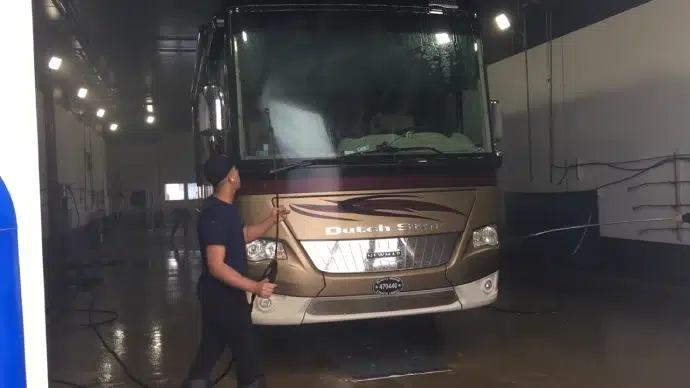Last Updated on May 3, 2023
Are you the proud owner of an RV that needs a good wash? Perhaps you’re wondering if taking your recreational vehicle to a truck wash is okay.
While using a truck wash facility to clean your RV is possible, there are certain risks and factors to consider. But before you grab your keys and head out the door, it’s important to know whether or not washing your RV at a truck wash is a safe option.
Understanding the risks involved, such as paint damage or water leaks, is crucial in deciding whether to use a truck wash. However, there are also benefits to using such facilities, including convenience and cost-effectiveness.
Discover the advantages and disadvantages of utilizing a truck wash for your recreational vehicle and helpful advice on keeping it in perfect condition.
Can I Wash My RV at a Truck Wash: Know the Pros and Cons
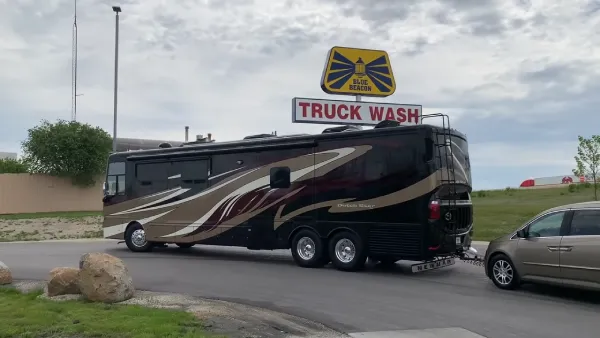
Washing your RV is an important part of its maintenance, but finding the right place to do it can be challenging. One option that many people consider is using a truck wash. But the question remains: can you wash your RV at a truck wash?
You can wash your RV at a truck wash. However, there are some risks involved that you should be aware of before taking this route. On the other hand, there are benefits to washing your recreational vehicle at a truck wash.
1. Understanding the Risks Involved
Truck washes are designed for commercial vehicles and may need more equipment or expertise to handle an RV properly. The high pressure and temperature of the water used in truck washes can damage the paint and caulking on your RV if not done correctly.
Another risk is that truck washes may need equipment suitable for cleaning an RV’s roof or hard-to-reach areas. This could result in incomplete cleaning, leaving dirt and grime behind.
It’s also important to consider the risk of damage from other vehicles in the truck wash bay. Large commercial vehicles may accidentally hit your RV with mirrors or cause other damage.
They typically have larger bays with more space for maneuvering, making it easier to clean hard-to-reach areas. Additionally, they often use specialized detergents and cleaning agents that can effectively remove dirt and grime from your RV.
2. Benefits of Washing Your RV at a Truck Wash
You can get a lot of benefits from washing your motorhome at a truck wash. First and foremost, it’s a quick and efficient way to get your RV clean.
Another advantage of rinsing your RV at a truck wash is that you don’t have to worry about making a mess. When you wash your RV at home, you may end up with water and soap all over your driveway or yard. The facility has drainage systems at a truck wash that prevent runoff from contaminating the environment.
Truck washes also use high-pressure water jets, which can help remove dirt and grime that may be difficult to remove with a regular hose. Many truck wash facilities offer additional services, such as waxing or polishing, which can help protect your RV’s paint job and keep it looking new.
What Factors to Consider Before Washing Your RV at a Truck Wash?
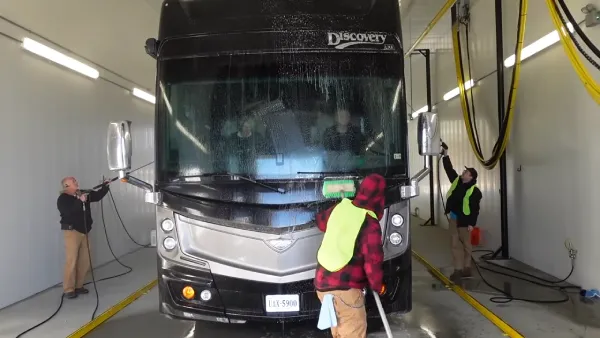
When considering washing your RV at a truck wash, there are several factors to consider before deciding. These factors include the size of your RV, the type of paint on your RV, water pressure and temperature, and the chemicals used in the wash.
1. Size of the RV:
Truck wash facilities are designed to handle large vehicles such as semi-trucks and trailers, but not all locations may be equipped to handle an RV. It’s essential to ensure that your chosen facility has enough space to accommodate your RV comfortably.
Some truck washes have limited space for larger vehicles, making maneuvering and cleaning your RV thoroughly challenging.
When selecting a truck wash facility, check the height clearance. Most truck washes have high clearance bays that can accommodate tall vehicles. However, some locations may need more height clearance for larger RVs with roof-mounted air conditioners or satellite dishes.
Before heading out to a truck wash facility, accurately measure your RV’s height and length. This information will help you identify a suitable facility to accommodate your vehicle without any issues.
2. Type of Paint on the RV
Different types of paint react differently to certain chemicals and water pressure, potentially damaging the paint job. For example, if your RV has an older or more delicate paint job, it may be more susceptible to scratches or fading from high-pressure water or harsh chemicals.
On the other hand, newer and more durable paints may withstand higher water pressure and stronger cleaning solutions.
To determine the paint type on your RV, you can check with the manufacturer or consult with a professional detailing service. They will be able to advise you on the best methods for cleaning and maintaining your specific RV’s paint job.
It’s also important to note that even if your RV has a strong and durable paint job, it’s still important to take precautions when washing at a truck wash. Choose a facility with gentle yet effective cleaning solutions and moderate water pressure.
3. Water Pressure and Temperature
High water pressure can damage the exterior of your RV, especially if it has any decals or graphics. A low-pressure setting or even a garden hose with a spray nozzle attachment is recommended to avoid potential damage.
Hot water can be beneficial for removing stubborn dirt and grime, but it’s important to ensure the temperature isn’t too high, as it can also cause damage. It’s best to check with the truck wash facility beforehand to ensure they have appropriate water settings for washing an RV.
4. Chemicals Used in Wash
Consider the chemicals used when washing your RV at a truck wash. Many truck wash facilities use harsh chemicals that may damage the paint and finish of your RV.
Some common chemicals used in truck washes include hydrofluoric acid. It can cause severe burns and is highly corrosive to metal surfaces and sodium hydroxide, which can damage aluminum and other metals.
These chemicals are often used to remove tough stains and grime from commercial trucks but may not be suitable for use on an RV.
It’s essential to ask the truck wash facility about the types of chemicals they use before proceeding with a wash. If you need more clarification about the safety of a particular chemical, consult with your RV manufacturer or a professional detailer.
Alternatively, some truck wash facilities offer eco-friendly or biodegradable cleaning solutions that are gentler on surfaces. These options are typically safer for use on an RV but may be less effective in removing stubborn dirt and grime.
How to Wash an RV at a Truck Wash?
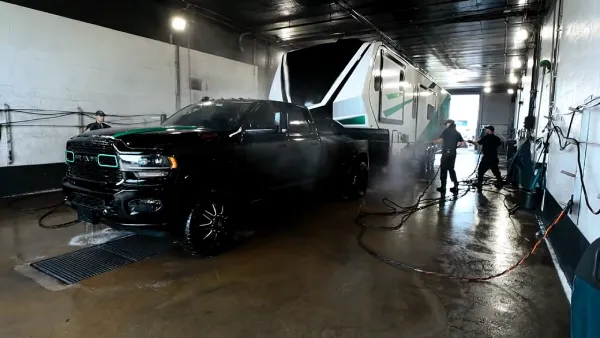
Washing your recreational vehicle (RV) at a truck wash is an efficient and convenient way to keep your vehicle clean, but it’s important to follow the right steps to ensure the process is safe for your RV. Here are the steps you should follow when washing an RV at a truck wash:
Step 1. Preparing Your RV for Wash:
Before taking your RV to a truck wash, prepare it for the wash. This will ensure that the wash is effective and does not cause any damage to your vehicle. Preparing your RV for a truck wash involves several steps.
Remove all loose items from the exterior of your RV. These include bicycles, chairs, tables, and anything else that can be removed. You don’t want these items to get damaged during the wash or cause damage to other vehicles.
Close all windows and doors tightly. This will prevent water from entering inside the RV and causing damage. Cover any vents or openings with plastic bags or duct tape. This will prevent water from entering through these openings.
Retract any awnings or slide-outs on your RV. These can get damaged during the wash. Check for leaks in your roof or windows. If there are leaks, fix them before going to a truck wash.
Step 2. Choosing the Right Truck Wash Facility:
Choosing the right facility is crucial when washing your RV at a truck wash. Not all truck washes are equipped to handle an RV’s size and specific needs. Here are some factors to consider when choosing a truck wash facility for your RV:
- Size: Make sure the truck wash can accommodate the size of your RV. Some facilities may have height or length restrictions preventing you from properly cleaning your vehicle.
- Equipment: Look for a truck wash that has equipment specifically designed for washing large vehicles like RVs. This includes high-pressure washers and long hoses that can reach all areas of your RV.
- Water temperature and pressure: Ensure that the water temperature and pressure suit your RV’s paint and materials. High-pressure water can damage some types of paint or caulking, so choosing a facility with adjustable water pressure settings is important.
- Chemicals used in the wash: Check what chemicals the truck wash uses in cleaning. Some harsh chemicals can strip away wax or damage certain materials on your RV.
- Reputation: Research reviews and ratings of different truck wash facilities before washing RV. Look for a facility with a good reputation for quality service and customer satisfaction.
Step 3. Pre-Wash Inspection:
Do a pre-wash inspection before you wash your RV. This involves examining the exterior of your RV for any damage or issues that could be exacerbated during the wash.
Start by checking for loose or damaged parts, such as mirrors, antennas, and awnings. These should be secured or removed before washing to prevent further damage. Inspect your RV’s roof for any cracks or leaks that could allow water to seep inside during the wash.
It’s also important to check the tires and wheels for damage or wear. Ensure they are properly inflated and have no signs of cracking or bulging. Ensure all windows and doors are tightly closed to prevent water from entering your RV.
Step 4. Applying Soap and Detergent:
When applying soap and detergent to your RV at a truck wash, use products specifically designed for vehicles. Using the wrong type of soap or detergent can ruin your RV’s paint and finish.
Before applying any soap or detergent, ensure you have thoroughly rinsed off any loose dirt or debris from the surface of your RV. This will prevent scratches and other damage from occurring during the wash.
When applying soap and detergent, start at the top of your RV and work your way down. This will ensure that you don’t miss any spots and that the soap doesn’t dry on the surface before you can rinse it off. Use a soft-bristled brush or sponge to apply the soap, making sure to work in small sections at a time.
Be sure to carefully follow the instructions on the soap or detergent packaging, as different products may have different dilution rates or application methods. Some soaps may need to be mixed with water before use, while others may be applied directly to the surface of your RV.
After applying the soap or detergent, let it sit for a few minutes to allow it to loosen any dirt or grime on the surface of your RV. Then, use a high-pressure spray nozzle to rinse off all traces of soap and detergent. Ensure you rinse thoroughly, as leftover soap residue can cause streaks and water spots on your RV.
Step 5. Rinsing Off the Soap and Detergent:
Rinse off all the soap and detergent properly when washing your RV at a truck wash. Failing to do so can leave behind residue that can damage your RV’s paint or attract dirt and grime.
To rinse the soap and detergent, use a high-pressure nozzle to spray down your RV. Ensure to cover every inch of the vehicle, including hard-to-reach areas like the roof and undercarriage. Use a back-and-forth motion to remove all soap suds from the surface.
After rinsing off the soap, inspect your RV for any remaining spots or streaks. If you notice any areas still with soap residue, gently scrub the remaining suds with a soft-bristled brush or sponge. Be careful not to scrub too hard, as this can scratch the paint on your RV.
Step 6. Drying Your RV After Wash
Drying your RV after washing it at a truck wash is an important step to prevent water spots and streaks on the surface of your vehicle. There are several ways to dry an RV, but the most effective method is to use a microfiber towel or chamois.
Make sure you have removed all excess water from the surface of your RV using a squeegee or air blower. Then, take a clean microfiber towel or chamois and start drying off the remaining water.
It’s important to note that using a regular towel or cloth can scratch the surface of your RV, so it’s best to invest in a high-quality microfiber towel or chamois specifically designed for drying vehicles.
Another option for drying your RV is to use a leaf blower. This method can be faster than towels, but it may not be as effective in removing all water droplets from hard-to-reach areas.
Alternatives to Washing an RV at a Truck Wash
A truck wash may only sometimes be the best option when washing an RV. There are several alternatives to consider that can provide a safer and more effective cleaning experience.
One alternative is hand washing your RV. This method allows you to have complete control over the pressure and temperature of the water and the cleaning agents used in the wash. It also lets you pay close attention to any areas needing extra attention or detailing.
Another alternative is using a mobile detailing service. These services bring all the necessary equipment and supplies directly to your location, allowing for a convenient and thorough cleaning experience without leaving your home or campground.
Some RV parks offer on-site washing facilities specifically designed for RVs. These facilities often include specialized equipment such as high-pressure hoses and adjustable wands, making them a safe and effective option for washing your RV.
What is the best way to wash your RV?
The best way to wash and clean your RV is to start by wetting down the surfaces to remove loose dirt. You can then use appropriate cleaners and brushes to soap up and brush down the sides of the RV.
Finish off by thoroughly rinsing the entire vehicle to ensure a spotless finish. It’s worth noting that when washing your RV, it is essential to take care and be mindful of the different components, such as the exterior surfaces, windows, tires, and awnings, among others.
How often should you wash an RV?
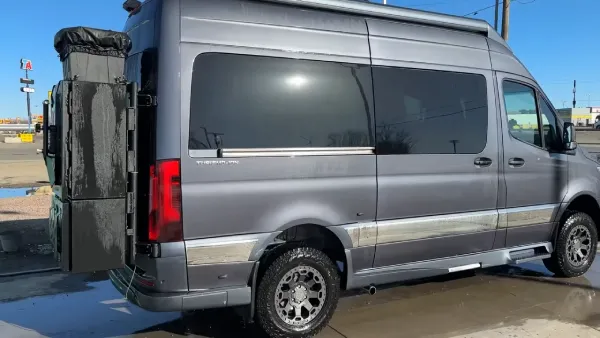
Washing your RV isn’t just about maintaining its appearance. It’s also about keeping it in good condition. Keep your RV in great shape by washing it twice a year, once in the spring and once in the fall.
However, if you frequently travel on dusty, muddy, or sandy terrain, you may need to wash your RV more often. Not washing your RV regularly can accumulate dirt and grime, which can damage its exterior and cause permanent stains.
Is it OK to pressure wash an RV?
When washing your RV, a pressure washer may seem a good option to save time and effort. However, it’s not recommended to pressure wash your RV as it can cause significant damage to your RV’s exterior surfaces and components.
The high-pressure water can easily penetrate crevices and seep into the RV’s interior, causing significant damage to the structure, insulation, and wiring.
Instead of pressure washing, use a low-pressure hose or a bucket of water combined with proper RV wash and cleaning solutions. This method will provide a thorough cleaning without risking any damage to the RV.
Pay attention to the types of cleaners and brushes you use to prevent damage or scratches. Following these steps will help ensure your RV looks great and performs even better for years.
Maximize the Convenience of Truck Washes for RV Owners
Washing your RV at a truck wash can be convenient for many RV owners. But you need to understand the risks and factors to consider before making this decision.
If you do choose to wash your RV at a truck wash, prepare your vehicle beforehand and choose the right facility. Conduct a pre-wash inspection and carefully apply soap and detergent, considering the chemicals used in the wash. Thoroughly rinse off all soap and detergent and dry your RV after the wash.

